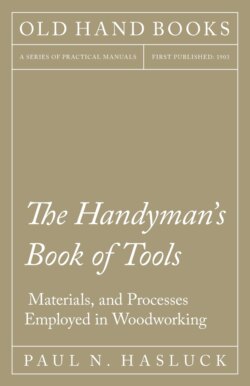Читать книгу The Handyman's Book of Tools, Materials, and Processes Employed in Woodworking - Paul N. Hasluck - Страница 111
На сайте Литреса книга снята с продажи.
STRAIGHTENING BUCKLED HAND SAW.
ОглавлениеA piece of iron with a flat, smooth surface, such as an anvil, or even a flat iron, will be required for straightening a bent or buckled hand saw. If a flat iron is used, it could be held firmly in a vice or a bench screw. Place the saw, with the convex side upwards, on the surface of the iron or anvil, and then hammer, but do not deal heavy blows. After every two or three strokes with the hammer the saw blade should be examined to see the effects. The surface of the hammer should be very slightly spherical, so as to prevent the possibility of leaving hammer marks on the blade. Much care and practice are required for hammering a saw properly. The plate of a hand saw being thin, requires a much lighter blow than steel of stout gauge. If the blows given are too heavy, they will indent and stretch the plate, and in consequence a bad state will be made worse. Fig. 317 represents a saw undulating, or wavy, lengthways of the plate at L, and bent or seamy across the plate at C. It will be seen that at L the blows are delivered across the plate, and at C lengthways of plate, using for the purpose a cross-pened hammer. Figs. 318 and 319 represent a saw that has a bend at the edge; in this case the cross-pened hammer should be used on the convex side, as at B (Fig. 318). and on the concave side, as at B (Fig. 319), after which it should be struck very lightly with a dog-head hammer, as indicated by round marks on both sides. Instead of the cross-pened hammer, the carpenter’s ordinary hammer will answer if the pene is ground a little convex.
Fig. 316.—Ripping Plank, End View.
Fig. 317.—Hand Saw Buckled Lengthways.
Fig. 318.—Buckled Hand Saw.
Fig. 319.—Buckled Hand Saw.
Fig. 320.—Straightening Buckled Tenon Saw.
